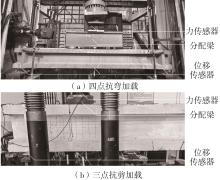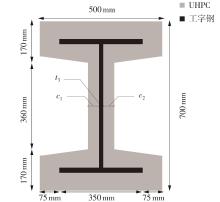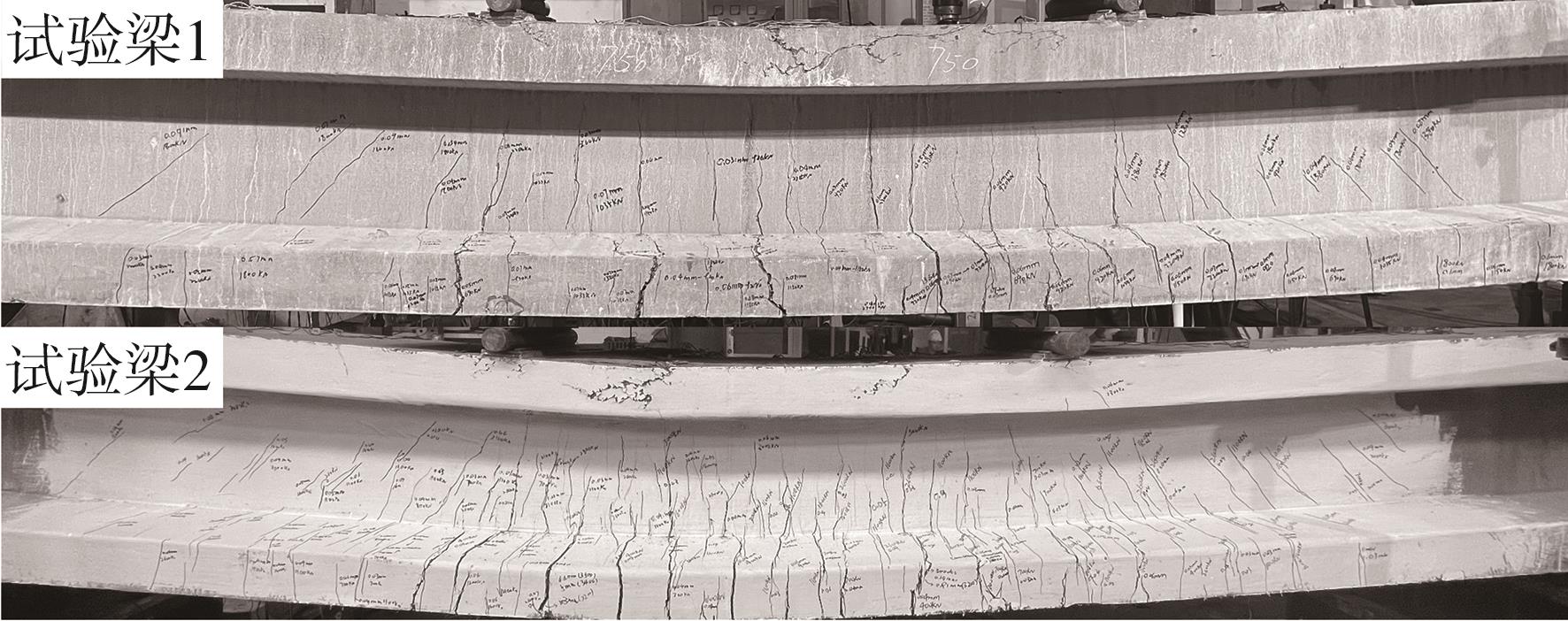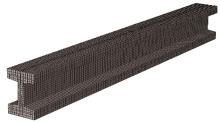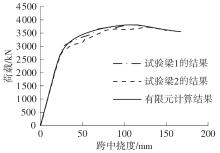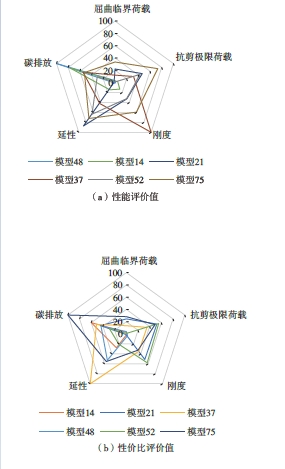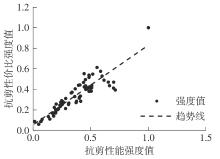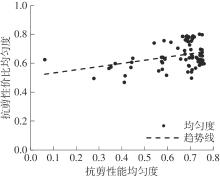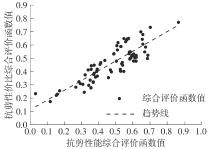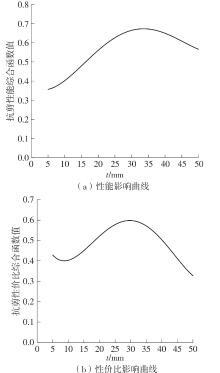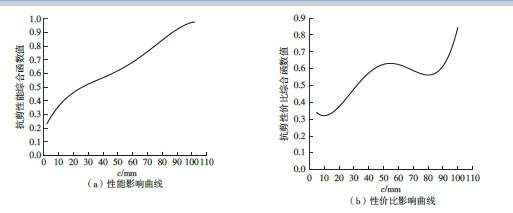Journal of South China University of Technology(Natural Science Edition) ›› 2025, Vol. 53 ›› Issue (4): 40-49.doi: 10.12141/j.issn.1000-565X.240332
• Architecture & Civil Engineering • Previous Articles Next Articles
Cost-Performance Analysis of Thin-Layer UHPC Encased I-Beam Shear Resistance
FAN Xueming, ZHOU Xiaopeng, YE Xiaohang, ZHAO Kun
- School of Civil Engineering and Transportation,South China University of Technology,Guangzhou 510640,Guangdong,China
-
Received:2024-06-27Online:2025-04-25Published:2024-09-27 -
About author:范学明(1979 —),男,博士,讲师,主要从事超高性能混凝土全产业链研究。E-mail: fanxm@scut.edu.cn -
Supported by:the National Natural Science Foundation of China(52278501)
CLC Number:
Cite this article
FAN Xueming, ZHOU Xiaopeng, YE Xiaohang, ZHAO Kun. Cost-Performance Analysis of Thin-Layer UHPC Encased I-Beam Shear Resistance[J]. Journal of South China University of Technology(Natural Science Edition), 2025, 53(4): 40-49.
share this article
Table 1
Response surface coefficients and mean relative errors"
| 响应面函数 | 系数 | ||||||
|---|---|---|---|---|---|---|---|
| 抗剪性能 | 1.34×10-1 | 4.04×10-3 | 2.00×10-3 | 9.50×10-3 | 5.937 | ||
| -4.70×10-2 | 7.42×10-3 | 7.09×10-4 | 2.66×10-2 | 4.820 | |||
| -3.00×10-5 | 1.27×10-5 | -3.77×10-4 | |||||
| -4.95×10-2 | 1.97×10-2 | -2.20×10-3 | 7.45×10-3 | 4.416 | |||
| -3.35×10-4 | 8.89×10-5 | 4.96×10-4 | |||||
| 2.04×10-6 | -5.17×10-7 | -1.10×10-5 | |||||
| -2.49×10-2 | 1.97×10-2 | 7.46×10-3 | -1.30×10-2 | 4.047 | |||
| -3.34×10-4 | -3.61×10-4 | 2.12×10-3 | |||||
| 2.30×10-6 | 6.75×10-6 | -6.04×10-5 | |||||
| -2.66×10-9 | -3.69×10-8 | 4.93×10-7 | |||||
| 抗剪性价比 | 2.19×10-1 | 1.88×10-3 | 3.49×10-3 | 4.35×10-3 | 6.570 | ||
| 4.51×10-2 | 4.62×10-3 | 4.52×10-3 | 1.75×10-2 | 6.028 | |||
| -2.85×10-5 | -9.93×10-6 | -2.93×10-4 | |||||
| 1.78×10-1 | 1.14×10-2 | -1.13×10-3 | -1.17×10-2 | 4.978 | |||
| -1.85×10-4 | 1.34×10-4 | 1.07×10-3 | |||||
| 9.97×10-7 | -9.44×10-7 | -1.79×10-5 | |||||
| 5.20×10-1 | -1.32×10-2 | -5.97×10-3 | -5.14×10-2 | 4.450 | |||
| 9.53×10-4 | 2.98×10-4 | 4.29×10-3 | |||||
| -1.82×10-5 | -2.86×10-6 | -1.13×10-4 | |||||
| 1.02×10-7 | 7.29×10-9 | 9.16×10-7 | |||||
| 1 | 侯保荣 .中国腐蚀成本[M].北京:科学出版社,2018. |
| 2 | 冯磊 .基于屈曲理论的典型结构强度分析[D].西安:长安大学,2003. |
| 3 | 陈绍蕃 .钢结构稳定设计指南[M].北京:中国建筑工业出版社,2013. |
| 4 | PARK S H, DONG J K, RYU G S, et al .Tensile behavior of ultra high performance hybrid fiber reinforced concrete[J].Cement & Concrete Composites, 2012, 34(2):172-184. |
| 5 | 钢结构设计标准: [S]. |
| 6 | 蔺军, 顾强, 董石麟 .梁腹板在弯、剪及局压复合应力作用下的屈曲分析[J].土木工程学报, 2005,38(7): 15-26. |
| LIN Jun, GU Qiang, DONG Shilin .Buckling analysis of beam webs subjected to combined bending,shear and patch loading[J].China Civil Engineering Journal, 2005, 38(7): 15-26. | |
| 7 | KÖVESDI B, ALCAINE J, DUNAI L, et al .Interaction behavior of steel I-girders part Ⅰ: longitudinally unstiffened girders[J].Journal of Constructional Steel Research,2014, 103: 327-343. |
| 8 | KÖVESDI B, ALCAINE J, DUNAI L, et al .Interaction behavior of steel I-girders part Ⅱ: longitudinally stiffened girders[J].Journal of Constructional Steel Research,2014, 103: 344-353. |
| 9 | 丁阳, 刘锡良 .《钢结构设计规范》(GB 50017—2002)焊接工字梁腹板的局部稳定和考虑屈曲后强度的计算[J].建筑结构学报, 2002, 23(3): 52-59. |
| DING Yang, LIU Xiliang .Design method of local buckling and post-buckling strength for welded I-beams[J].Journal of Building Structures,2002,23(3):52-59. | |
| 10 | 童根树, 任涛 .工字梁的抗剪极限承载力[J].土木工程学报, 2006, 39(8): 57-64. |
| TONG Genshu, REN Tao .Shear resistance of slender webs in I-girders[J].China Civil Engineering Journal, 2006, 39(8): 57-64. | |
| 11 | 康孝先, 强士中 .工字梁腹板拉力场理论的修正[J].西南交通大学学报, 2008, 43(1): 77-81. |
| KANG Xiaoxian, QIANG Shizhong .Modification of tension field theory on I-girder web[J].Journal of Southwest Jiaotong University, 2008, 43(1): 77-81. | |
| 12 | 朱一云, 赵金城 .短深大板梁承载性能与破坏模式研究[J].土木工程学报, 2018, 51(2): 54-61. |
| ZHU Yiyun, ZHAO Jincheng .Study on load-bearing capacity and failure mode of short-deep plate girders[J].China Civil Engineering Journal, 2018, 51(2): 54-61. | |
| 13 | VOO Y L, FOSTER S . Characteristics of ultra-high performance ‘ductile’concrete and its impact on sustainable construction [J].The IES Journal Part A: |
| Civil, Structural Engineering, 2010, 3(3): 168-187. | |
| 14 | ROUX N, ANDRADE C, SANJUAN M A .Experimental study of durability of reactive powder concretes [J].Journal of Materials in Civil Engineering, 1996, 8(1): 1-6. |
| 15 | JOOSS M, REINHARDT H W .Permeability and diffusivity of concrete as function of temperature [J].Cement and Concrete Research, 2002, 32(9): 1497-1504. |
| 16 | 唐爱华, 王尚伟, 金凌志, 等 .不同矿物掺合料对RPC抗氯离子渗透性的研究[J].河南理工大学学报(自然科学版), 2015, 34(1): 116-123. |
| TANG Aihua, WANG Shangwei, JIN Lingzhi, et al .Study on RPC-resistance chloride ion penetration of different mineral admixtures[J].Journal of Henan Polytechnic University (Natural Science), 2015, 34(1): 116-123. | |
| 17 | EL-DIEB A S .Mechanical, durability and microstructural characteristics of ultra-high-strength self-compacting concrete incorporating steel fibers [J].Materials and Design, 2009, 30(10): 4286-4292. |
| 18 | WANG Y, AN M Z, YU Z R, et al .Durability of reactive powder concrete under chloride-salt freeze-thaw cycling [J].Materials and Structures, 2017, 50(1): |
| 18/ 1-9. | |
| 19 | ALKAYSI M, EL-TAWIL S, LIU Z C, et al .Effects of silica powder and cement type on durability of ultra high performance concrete (UHPC) [J].Cement and Concrete Composites, 2016, 66(2): 47-56. |
| 20 | LIU J H, SONG S M, WANG L .Durability and micro-structure of reactive powder concrete [J].Journal of Wuhan University of Technology-Materials Science, 2009, 24(3): 506-509. |
| 21 | GRAYBEAL B A .Material property characterization of ultra-high performance concrete [M].Georgetown Pike: |
| Federal Highway Administration, 2006. | |
| 22 | SHI C, WU Z, XIAO J, et al .A review on ultra high performance concrete (part I):raw materials and mixture design[J].Construction and Building Materials,2015, 101: 741-751. |
| 23 | 刘新华, 周聪, 张建仁, 等 .钢-UHPC 组合梁负弯矩区受力性能试验[J].中国公路学报, 2020, 33(5):110-121. |
| LIU Xin-hua, ZHOU Cong, ZHANG Jian-ren, et al .Experiment on negative bending behavior of steel-UHPC composite beams[J].China Journal of Highway and Transport,2020, 33(5): 110-121. | |
| 24 | 伍贤智, 姜志刚, 王敏 .基于静动载试验的钢-UHPC 组合桥面应用研究[J].桥梁建设, 2021,51(5):67-73. |
| WU Xian-zhi, JIANG Zhi-gang, WANG Min .Study of application of steel-UHPC composite deck based on static and dynamic load tests[J].Bridge Construction, 2021, 51(5): 67-73. | |
| 25 | 程斌, 田亮, 孙斌, 等 .超高性能混凝土铺层提升钢桥面板疲劳性能试验研究[J].同济大学学报(自然科学版), 2021, 49(8): 1097-1106. |
| CHENG Bin, TIAN Liang, SUN Bin, et al .Experimental study of fatigue behaviors of orthotropic steel bridge decks enhanced by the ultra-high performance concrete layer[J].Journal of Tongji University (Natural Science), 2021, 49(8): 1097-1106. | |
| 26 | 王皓磊, 孙韬, 刘晓阳, 等 .钢-UHPC 连续组合梁抗弯性能试验[J].中国公路学报, 2021, 34(8):218-233. |
| WANG Hao-lei, SUN Tao, LIU Xiao-yang, et al .Experimental investigation on flexural capacity of steel-UHPC continuous composite girder[J].China Journal of Highway and Transport, 2021, 34(8): 218-233. | |
| 27 | 广东省水利电力勘测设计研究院有限公司 .工作井屋盖及吊车梁劲性钢-UHPC组合梁关键技术研究结题验收报告[R].广州:广东省水利电力勘测设计研究院有限公司,2023. |
| 28 | 王青 .纤维网格增强超高性能混凝土加固钢筋混凝土梁受剪性能试验研究[J].菏泽学院学报, 2023, 45(5): 65-71. |
| WANG Qing .Experimental study on shear performance of fiber mesh reinforced ultra-high-performance concrete for strengthening reinforced concrete beams[J].Journal of Heze University, 2023, 45(5): 65-71. | |
| 29 | 江东, 邵永波, 邓利霞, 等 .钢管高强灌浆料翼缘-波纹腹板曲梁抗剪性能分析[J].重庆大学学报, 2023, 46(10): 22-39. |
| JIANG Dong, SHAO Yongbo, DENG Lixia, et al .Analysis of shear behavior for curved girders with rectangular grouted tubular flange and corrugated web[J].Journal of Chongqing University, 2023, 46(10): 22-39. | |
| 30 | 聂建国,王宇航 .ABAQUS中混凝土本构模型用于模拟结构静力行为的比较研究[J].工程力学, 2013, 30(4): 59-67,82. |
| NIE Jian-guo, WANG Yu-hang .Comparison study of constitutive model of concrete in Abaqus for static analysis of structures[J].Engineering Mechanics, 2013, 30(4): 59-67,82. | |
| 31 | 胡翱翔 .超高性能混凝土单轴受压力学性能试验研究及理论分析[J].深圳职业技术学院学报, 2022, 21(5): 47-53. |
| HU Aoxiang .Experimental and theoretical analysis of uni-axial compressive performance of UHPC[J].Journal of Shenzhen Polytechnic,2022, 21(5):47-53. | |
| 32 | 胡翱翔, 梁兴文, 于婧, 等 .超高性能混凝土轴心受拉力学性能试验研究[J].湖南大学学报(自然科学版),2018, 45(9): 30-37. |
| HU Aoxiang, LIANG Xingwen, YU Jing, et al .Experimental study of uniaxial tensile characteristics of ultra-high performance concrete[J].Journal of Hunan University(Natural Sciences), 2018, 45(9): 30-37. | |
| 33 | 徐翔波, 金祖权, 于泳, 等 .基于雷达图模型的超高性能混凝土(UHPC)配合比设计及性能评价[J].材料导报, 2022, 36(72): 22030245/1-7. |
| XU Xiangbo, JIN Zuquan, YU Yong, et al .Mix design and performance evaluation of ultra high performance concrete (UHPC) based on radar chart model[J].Materials Reports, 2022, 36(72): 22030245/1-7. | |
| 34 | 武芳文, 冯彦鹏, 王广倩, 等 .高温后钢-混组合梁抗剪性能试验研究[J].工程力学, 2023, 40(9):48-60. |
| WU Fang-wen, FENG Yan-peng, WANG Guang-qian,et al .Experimental study on shear performance of steel-concrete composite beams after experiencing high temperatures[J].Engineering Mechanics, 2023, 40(9):48-60. | |
| 35 | 韦芳洲 .超高性能混凝土板弯曲性能研究[D].广州:华南理工大学, 2023. |
| 36 | 贾子杰 .超高性能混凝土的全生命周期碳排放测算研究[D].包头:内蒙古科技大学,2023. |
| 37 | 建筑碳排放计算标准: [S]. |
| 38 | 中国水泥网 .水泥价格行情查询平台[EB/OL]. (2024-05-12)[2024-05-12].. |
| 39 | 我的钢铁网 .钢材价格查询平台[EB/OL]. (2024-09-10)[2024-09-12].. |
| 40 | 海军, 宋秉龙 .运用雷达图分析法开展航空运输投送能力评估探析[J].国防交通工程与技术, 2021, 19(5):17-19, 28. |
| Jun HAI, SONG Binglong .Analysis on the evaluation of air transport projection capability by using radar chart method[J].Traffic Engineering and Technology for National Defense, 2021, 19(5):17-19, 28. | |
| 41 | 王永菲, 王成国 .响应面法的理论与应用[J].中央民族大学学报(自然科学版), 2005, 14(3): 236-240. |
| WANG Yongfei, WANG Chengguo .The application of response surface methodology[J].Journal of the CUN(Natural Sciences Edition), 2005, 14(3): 236-240. | |
| 42 | 贡金鑫 .工程结构可靠度计算方法[M].大连:大连理工大学出版社,2003. |
| [1] | Li Guang-xing Cai Jian. Experimental Research on the Unbonded Prestressed Concrete Flat Slab-T-shaped Column Connections Under Gravity Loads [J]. Journal of South China University of Technology(Natural Science Edition), 2004, 32(12): 43-46. |
| Viewed | ||||||
|
Full text |
|
|||||
|
Abstract |
|
|||||
